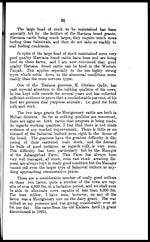Medicine - Veterinary > Civil Veterinary Departments > 1894-1932 - Annual report of the Punjab Veterinary College and of the Civil Veterinary Department, Punjab > 1926-1932 > 1927-1928 - Annual report on the Punjab Veterinary College, Civil Veterinary Department, Punjab, and the Government cattle farm, Hissar, for the year 1927-28
(304) Page 32
Download files
Individual page:
Thumbnail gallery: Grid view | List view

32
Annual Report of Live Stock Officer 1927-28.
I remained in charge of the office of Live Stock Officer
for the whole of year under report. Unfortunately owing to
shortage of staff, I also had to retain charge of the Govern-
ment Cattle Farm, Hissar, throughout the year as well.
Work on the Government Cattle Farm, Hissar, tends every
year to increase and consequently I have been able to spare
very little time to develop the work of the Live Stock
Officer. The post of Deputy Superintendent to the Live
Stock Expert has been vacant throughout the year. As Live
Stock Expert I toured for 93 days.
The work I have attempted to carry on as Live Stock
Officer may be roughly divided into two heads.
First.—Work in connection with Government Grantee
Cattle Farms.
Second.—Other work which is detailed shortly below.
This work can be much extended as soon as the Department
is staffed.
I.—GRANTEE CATTLE FARMS.
There are seven of these at present, 6 for cattle breeding—
(5 large grants to single grantee, and one to a number of
small holders under a manager) and one dairy grant. Three
of the above are for Harriana or Hissar Cattle, and two and the
small holders grant for Sahniwal or Montgomery cattle.
The Dairy grantee has by his conditions to maintain a
minimum number of 150 cattle of which 105 must be cows,
the rest may be buffaloes (50 per cent. to be in milk). His
cows are of the Sahniwal breed.
All the cattle breeding grants are, on the analogy of
similar horse breeding grants, over-stocked. The horse
breeders have usually been granted 50 acres for one mare,
and are permitted to sell produce soon after weaning.
The cattle breeders have to maintain on an average one cow
per 8 or 9 acres with the additional onus of rearing a proportion
of their young stock up to an average age of 4 years.
I do not mean to infer that the land is not capable of pro-
ducing fodder for the heads of stock maintained. I merely
wish to indicate that assuming the land has been granted as
an inducement for carrying on the relatively unprofitable
business of horse and cattle breeding how much greater the
encouragement for horse breeding is. This is not as it should
be. From an economic point of view, horse breeding now, as
compared to cattle breeding, is of very minor importance.
Set display mode to: Large image | Zoom image | Transcription
Images and transcriptions on this page, including medium image downloads, may be used under the Creative Commons Attribution 4.0 International Licence unless otherwise stated. ![]()
| Permanent URL | https://digital.nls.uk/75537997 |
|---|
| Additional NLS resources: |
|---|




